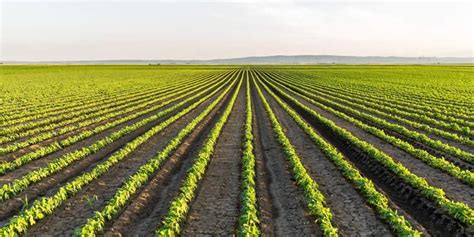Introduction
Monoculture, the practice of cultivating a single crop on a large scale, is a common phenomenon in modern agriculture. While it offers certain advantages, such as increased efficiency and reduced costs, it also raises concerns about sustainability, biodiversity loss, and social equity. This article delves into the concept of monoculture in AP Human Geography, examining its implications for food security, environmental degradation, and the social fabric of rural communities.

Causes and Consequences of Monoculture
Agricultural Efficiency and Economic Benefits
Monoculture emerged as a response to the increasing demand for food during the Green Revolution. By focusing on a single crop, farmers could optimize production through specialized machinery, advanced irrigation systems, and tailored fertilizers. This resulted in higher yields and lower production costs, making it an economically viable option for large-scale agriculture.
Environmental Impacts
The environmental consequences of monoculture are significant. The repetitive cultivation of a single crop depletes soil nutrients, leading to a decline in soil fertility. This, in turn, requires increased use of synthetic fertilizers, which contribute to water pollution and eutrophication. Monocultures also reduce biodiversity, as they eliminate native plant species that provide habitat and food for wildlife. This loss of biodiversity can disrupt ecosystem services, such as pollination and natural pest control.
Social Impacts
Monoculture can have profound social consequences. By favoring large-scale operations, it often leads to the displacement of small-scale farmers. This can result in increased poverty and inequality in rural areas. Additionally, the use of mechanized agriculture and synthetic fertilizers can reduce employment opportunities in farming and related industries.
Regional Case Studies
The Soy Boom in Brazil
Brazil is a prime example of the rapid expansion of monoculture. Soybean production has soared in recent decades, with Brazil becoming the world’s largest soybean exporter. However, this expansion has come at a cost to the environment. Soy plantations have replaced vast areas of native forest, contributing to deforestation and biodiversity loss. It has also led to increased soil erosion, water pollution, and social displacement.
Rice Production in the Mekong Delta
In the Mekong Delta region of Vietnam, rice monoculture has fueled economic growth but has also raised concerns. The intensive use of fertilizers and pesticides has caused water pollution and soil salinization. The loss of natural vegetation has also increased vulnerability to climate change, such as flooding and droughts.
Addressing the Challenges of Monoculture
Diversification and Agroforestry
Promising solutions to address the challenges of monoculture include crop diversification and the integration of agroforestry practices. By introducing a variety of crops, farmers can reduce the risks associated with pests, diseases, and climate variability. Agroforestry systems, which combine trees and crops on the same land, can enhance soil fertility, reduce erosion, and provide additional income sources.
Sustainable Agriculture Practices
Adopting sustainable agriculture practices can also mitigate the negative impacts of monoculture. These practices include conservation tillage, precision agriculture, and the use of cover crops. Conservation tillage minimizes soil disturbance, while precision agriculture ensures that fertilizers and pesticides are applied only where and when needed. Cover crops improve soil health and suppress weeds.
Community-Supported Agriculture
Community-supported agriculture (CSA) is a model that fosters a direct connection between farmers and consumers. By purchasing shares of a farm’s harvest, consumers support local farmers and encourage sustainable practices. CSA also fosters a sense of community and provides access to fresh, healthy food.
Conclusion
Monoculture has played a significant role in modern agriculture, but its long-term sustainability is questionable. The environmental, social, and economic consequences of monoculture demand a multifaceted approach to address its challenges. By embracing diversification, sustainable practices, and community-supported agriculture, we can create a more resilient and equitable food system that respects the interconnectedness of humans and nature.
FAQs
1. What are some of the specific environmental impacts of monoculture?
- Soil nutrient depletion
- Loss of biodiversity
- Water pollution from synthetic fertilizers
- Soil erosion and salinization
2. How does monoculture affect rural communities?
- Displacement of small-scale farmers
- Increased poverty and inequality
- Reduced employment opportunities
3. What are some of the benefits of crop diversification and agroforestry?
- Reduces risks associated with pests, diseases, and climate variability
- Enhances soil fertility and reduces erosion
- Provides additional income sources for farmers
4. How does community-supported agriculture contribute to sustainable food systems?
- Fosters a direct connection between farmers and consumers
- Supports local farmers and sustainable practices
- Provides access to fresh, healthy food
Tables
Table 1: Global Monoculture Statistics
| Crop | Total Area Planted (ha) |
|---|---|
| Wheat | 220 million |
| Rice | 168 million |
| Maize | 194 million |
| Soybeans | 120 million |
| Sugarcane | 26 million |
Table 2: Environmental Impacts of Monoculture
| Impact | Description |
|---|---|
| Soil nutrient depletion | Reduced soil fertility due to repetitive cultivation of the same crop |
| Loss of biodiversity | Elimination of native plant species and associated wildlife |
| Water pollution | Runoff from synthetic fertilizers and pesticides contaminating water bodies |
| Soil erosion | Removal of soil by wind or water, exacerbated by monoculture practices |
Table 3: Social Impacts of Monoculture
| Impact | Description |
|---|---|
| Displacement of small-scale farmers | Loss of land and livelihood for subsistence farmers |
| Increased poverty and inequality | Widening gap between large-scale farmers and rural communities |
| Reduced employment opportunities | Mechanized agriculture and synthetic fertilizers reducing job availability |
Table 4: Sustainable Alternatives to Monoculture
| Practice | Benefits |
|---|---|
| Crop diversification | Reduces risks, enhances soil health, provides income diversity |
| Agroforestry | Improves soil fertility, reduces erosion, provides additional income |
| Conservation tillage | Minimizes soil disturbance, conserves soil and moisture |
| Precision agriculture | Targets fertilizer and pesticide application, reducing environmental impact |
